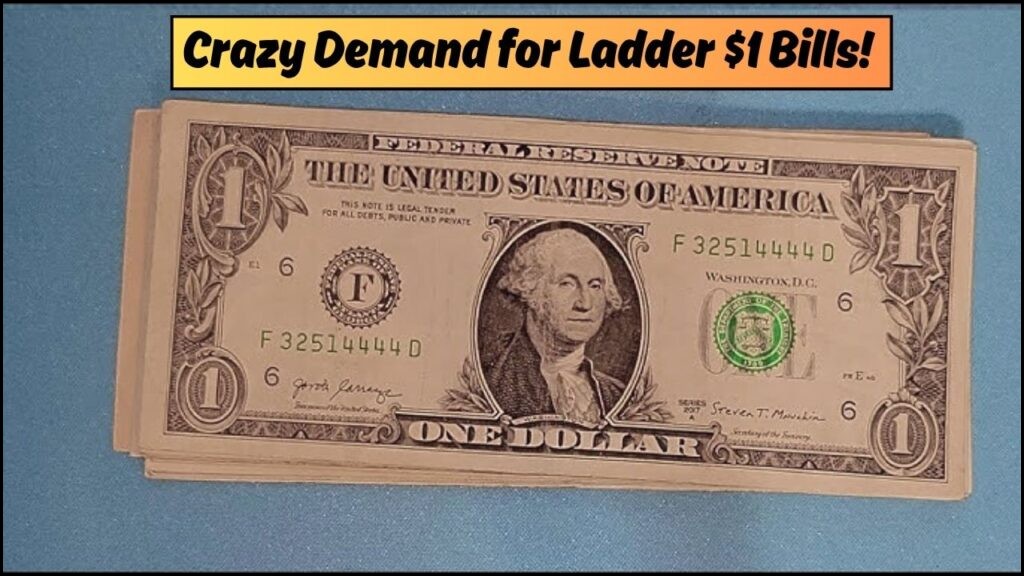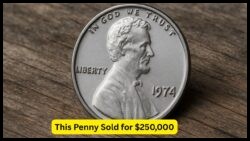$1 Bills – In the fascinating world of rare currency collecting, not all valuable treasures are gold or silver. Sometimes, it’s the simplest-looking $1 bill that sends collectors into a frenzy. Recently, United States collectors have shown growing excitement over a special kind of $1 note known as the “Ladder Serial Number” bill. These are ordinary paper dollars in appearance, but their unique serial numbers can make them worth thousands of dollars on the resale market. Some have reportedly sold for as much as $14,000, and the craze is only gaining momentum in 2025. If you’ve ever glanced at the serial number on your $1 note and thought nothing of it, you may want to take a second look. In this article, we’ll break down what ladder serial numbers are, why they’re so valuable, and how you can identify whether the cash in your wallet is secretly a collector’s jackpot.
What is a “Ladder” Serial Number on a $1 Bill?
Ladder serial numbers are incredibly rare patterns found in the serial numbers printed on U.S. currency.
- These serial numbers consist of a perfectly ascending or descending sequence of numbers.
- For example:
- Ascending Ladder:
12345678 - Descending Ladder:
87654321
- Ascending Ladder:
- They are called “ladders” because the numbers climb or fall like steps.
These sequential notes are extremely difficult to come across, and that rarity is what fuels the skyrocketing collector interest.
Why Are Ladder Notes So Valuable?
A ladder serial number is not just cool to look at—it’s exceptionally scarce.
- There are only 32 possible true 8-digit ladder combinations in U.S. currency.
- With millions of bills printed annually, the odds of finding a true ladder are about 1 in 96 million.
- This rarity drives up the value among numismatists and collectors.
- A bill with a ladder serial number can fetch $3,000 to $14,000, depending on its condition, denomination, and age.
The demand for these bills has significantly increased, especially after multiple high-profile auctions drew attention on platforms like eBay and Heritage Auctions.
How to Identify a Ladder $1 Bill
Here are some quick tips to check your wallet for a potential treasure:
- Look at the serial number (top right and bottom left of the bill).
- Identify if the serial number has all eight digits in order, without any repeats.
- Valid ladder sequences include:
12345678,23456789,34567890(ascending)87654321,98765432,09876543(descending)
- No skips, no duplicates, and all digits must be different.
If your note has any of the above patterns, you might be holding onto a valuable piece of currency history.
Estimated Value Chart for Ladder Bills
Below is a table showing the potential resale value for $1 bills with ladder serial numbers, depending on condition and type:
| Serial Number Type | Bill Condition | Estimated Value |
|---|---|---|
| Ascending (12345678) | Crisp Uncirculated | $10,000 – $14,000 |
| Descending (87654321) | Crisp Uncirculated | $9,000 – $12,000 |
| Partial Ladder (e.g. 34567812) | Good Condition | $800 – $3,000 |
| Slightly Worn Full Ladder | Circulated | $2,000 – $6,000 |
| Star Note + Ladder | Mint Condition | $12,000 – $15,000 |
| Repeated Ladder Patterns | Fair Condition | $500 – $1,500 |
| Older Series with Ladder | Excellent Condition | $7,000 – $11,000 |
Where and How to Sell Your Ladder $1 Bill
If you believe you have a ladder note, here’s how you can cash in:
- Online Auctions:
- eBay is a popular choice—some bills have gone viral here.
- Heritage Auctions also caters to professional currency collectors.
- Currency Dealers:
- Contact reputable numismatic dealers for direct sales.
- They often authenticate and buy rare bills.
- Grading Services:
- Consider having your bill graded by PCGS or PMG to certify its value.
- Collector Forums:
- Facebook groups and Reddit communities often have serious buyers looking for ladder bills.
Other Rare Serial Numbers Worth Checking
While ladder notes are the highlight, these rare serial number types are also valuable:
| Serial Number Pattern | Description | Value Range |
|---|---|---|
| Radar Notes | Same forwards and backwards (e.g. 12344321) | $100 – $1,500 |
| Repeaters | Numbers repeat in pairs (e.g. 34343434) | $80 – $700 |
| Solid Numbers | All digits the same (e.g. 77777777) | $1,000 – $5,000 |
| Binary Notes | Only 2 digits used (e.g. 01010101) | $200 – $3,000 |
| Birthday Notes | Format like 01011990 (MMDDYYYY) | $50 – $800 |
| Low Serial Numbers | Starts with 00000001 | $500 – $4,000 |
| High Serial Numbers | Ends with 99999999 | $300 – $2,000 |
Who would’ve thought a $1 bill could be worth thousands? As more collectors dive into serial number patterns, ladder notes are emerging as one of the hottest trends in numismatics. Whether you’re a seasoned collector or a curious citizen, taking a quick look at the serial numbers on your cash could uncover a hidden gem. If you spot a perfect ladder, don’t spend it—certify it, preserve it, and list it! You might just be holding one of the rarest $1 bills in the world.
FAQs of $1 Bills
Q1. What is a ladder serial number on a dollar bill?
A ladder serial number is a sequence where all digits are in perfect ascending (e.g. 12345678) or descending (e.g. 87654321) order.
Q2. How rare are ladder $1 bills?
Extremely rare—only 32 true combinations exist, with odds of 1 in 96 million of finding one.
Q3. Can used or circulated ladder bills still have value?
Yes, even circulated bills can sell for thousands if the serial number is complete and clear.
Q4. Where can I sell a rare serial number bill?
You can sell it on eBay, through auction houses like Heritage, or directly to collectors and dealers.
Q5. Are other serial number patterns valuable too?
Yes, patterns like radar, repeater, solid, binary, and birthday notes also fetch good money depending on condition and demand.






